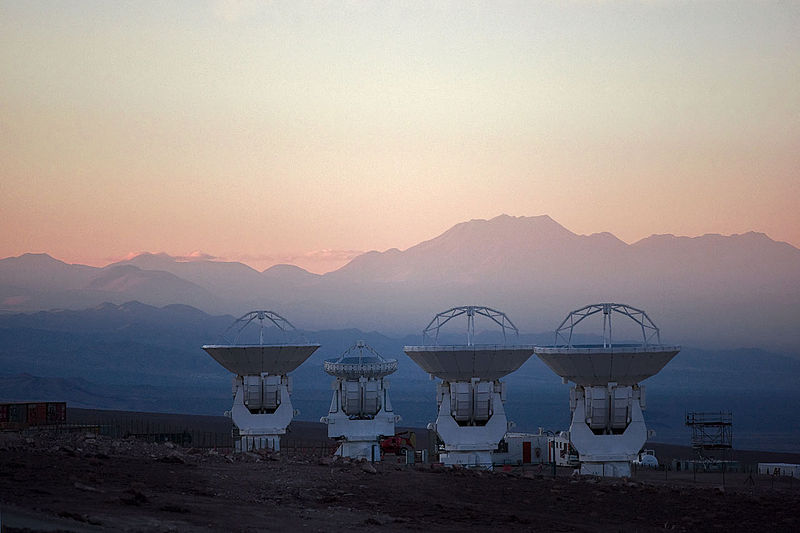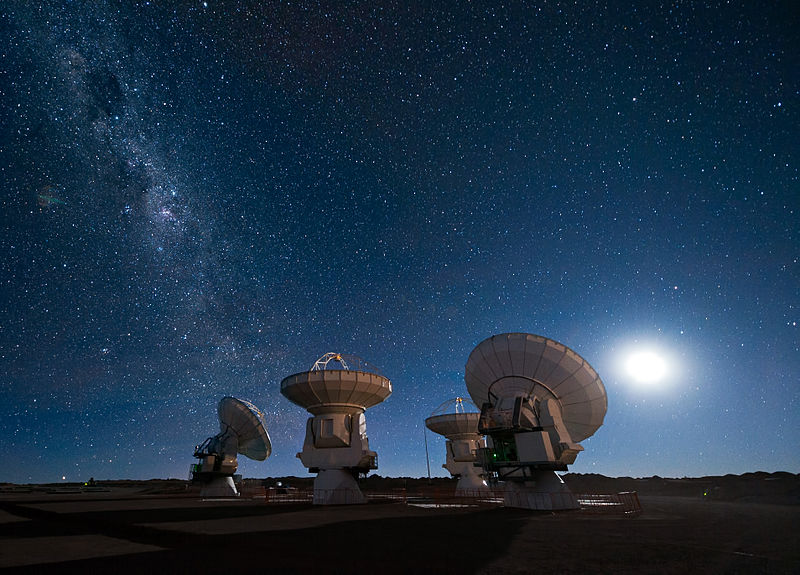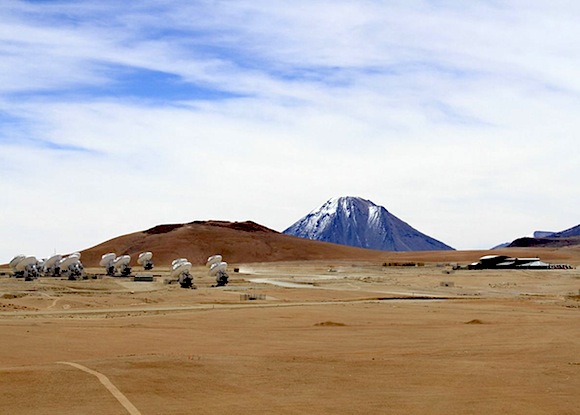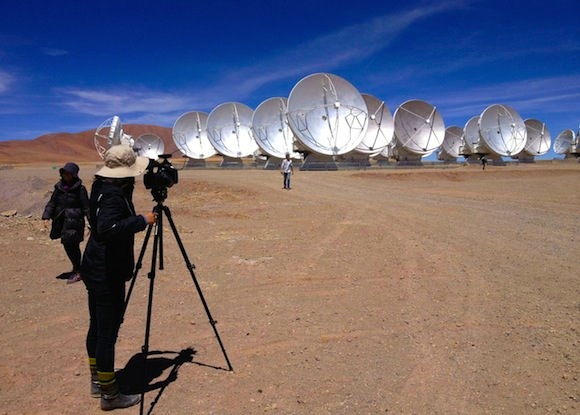
On March 13, 2013, the ALMA Telescope in northern Chile officially went online. The inauguration ceremony took place in Chile’s high desert at an altitude of 16,500 feet, or 5,000 meters. ALMA is the most ambitious and complex Earth-based observatory yet undertaken. The ALMA array is able to expand its scattering of antenas to a maximum distance of 15 kilometers (10 miles) of separation between any two antennas in the array. In other words, all of these dishes working together can expand to the equivalent of a 15 kilometer-wide single telecope dish. When running at its maximum observational power, ALMA will see the universe at a resolution 10 times greater than that of the Hubble Space Telescope.
ALMA stands for Atacama Large Millimeter/Sub Millimeter Array. And the telescope is very powerful – the most powerful yet constructed. An EarthSky team covered the inauguration on-site. They emailed back tales of oxygen depravation from the high mountains of Chile’s Atacama desert, amid the excitement of bringing this instrument fully online.

In fact, at 5,000 km (16,500 feet), the ALMA array’s supercomputer is housed in the world’s second-highest building (the first-highest is a train station in Tibet). To save themselves from oxygen depravation during their observing runs, astronomers undertake observations at a base site further down the mountain.
The oxygen is so thin at this height that technicians are not allowed to work on site for more than six hours at a time, and must keep oxygen with them at all times. But ALMA’s height above sea level, and the aridity of the surrounding Atacama desert, are important to limit interference from water vapor in the Earth’s atmosphere. In other words, ALMA’s altitude – above 40% of Earth’s atmosphere – is part of what makes it so powerful.
This telescope is expected to complement other existing telescopes by providing data about the universe at a very high resolution and in a frequency of the electromagnetic spectrum (submillimeter and millimeter) that is able to provide access to understanding the dark, cold, distant universe. ALMA will penetrate clouds of dust and gas to help astronomers study the birth of planets, stars, and galaxies. It’ll be able to look 12 billion years back in time to create a picture-book of the history of the universe (our universe is believed to be about 13.77 billion years old). It’ll probe our origins in a way that no other telescope has before.
That’s one reason astronomers called this new telescope ALMA, which is the Spanish word for soul.

According to the scientists who conceived and built ALMA, one nation alone couldn’t build ALMA. Working with the host country Chile, some of the largest observatories in the world joined together for ALMA. These include the National Radio Astronomy Observatory in North America, the European Southern Observatory, and observatories in Japan, Brazil and throughout Latin America.
Sixty-six large radio dishes connect together to form ALMA. These dishes are located 30 minutes by car from the town of San Pedro de Atacama in Chile.
At that height and in the desert, there is little water vapor in the air. Those conditions are perfect for ALMA because water in the air blocks starlight in the portion of the electromagnetic spectrum that scientists want to study. ALMA will observe starlight at wavelengths invisible to your eye – the long infrared wavelengths of starlight. Space observatories, like the Hubble Space Telescope, orbit high above the blanket of Earth’s atmosphere to see the universe at these wavelengths. Astronomers hope that ALMA will be even better than space telescopes at exploring the infrared universe – because they have designed and built the telescope much larger on land than they could in space today.
What do astronomers expect to learn with ALMA?
They hope to learn the details of where stars like our sun and planets like our Earth come from. Today, the process of star and planet formation is poorly understood. The ALMA array – with its ability to see in infrared wavelengths – will help us probe the vast clouds of dust surrounding new stars and planets.


Farther away in space, and farther back in time, are very distant galaxies – believed to have undergone an extreme burst of star formation long ago, as the universe evolved toward its present state. Astronomers want to use ALMA to learn how this burst of star formation began, how long it lasted, and what it may mean for the part of the universe we inhabit today.
Even before construction ended, ALMA had already verified an astronomical theory stating that star formation heightens when galaxies collide. In 2011, as the dishes of ALMA began to come online, astronomers used them to look at the Antennae Galaxies – two large spiral galaxies like our Milky Way – known to be undergoing a vast cosmic collision.
ALMA found signs of gas clouds crashing into each other in the Antennae Galaxies, in places where new stars are forming. That discovery verified astronomers’ theories that a shock wave from a colossal collision might initiate star formation.
It’s a glimpse of a violent past for our universe that might provide clues to how ordinary stars like our sun – and planets like our Earth – came to be.

Bottom line: The ALMA telescope in northern Chile was inaugurated on March 13, 2013. It is the largest and most powerful telescope in the world. ALMA – the Spanish word for “soul” – stands for Atacama Large Millimeter/Submillimeter Array.











